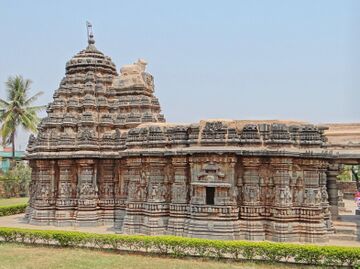Ishvara/is: Difference between revisions
No edit summary |
(Created page with "Hinn 30. júní 1995 sagði Ishvara:") |
||
| Line 15: | Line 15: | ||
<blockquote>I am the one, Ishvara.... I am in the light of the Holy of holies, in the within of the flame and in the [[secret chamber of the heart|secret chamber]] of the within. Come and find me in the center of the one that is thy life. Come and seek me to know my name and thus know the inner key to the release of that energy that will only give to thee life and life everlasting.<ref>Ishvara, “The Quivering of a Cosmos,” September 4, 1977.</ref></blockquote> | <blockquote>I am the one, Ishvara.... I am in the light of the Holy of holies, in the within of the flame and in the [[secret chamber of the heart|secret chamber]] of the within. Come and find me in the center of the one that is thy life. Come and seek me to know my name and thus know the inner key to the release of that energy that will only give to thee life and life everlasting.<ref>Ishvara, “The Quivering of a Cosmos,” September 4, 1977.</ref></blockquote> | ||
Hinn 30. júní 1995 sagði Ishvara: | |||
<blockquote> | <blockquote> | ||
Revision as of 12:48, 13 April 2025

Ishvara er sanskrítarorð sem þýðir „Drottinn alheimsins“ eða „Drottinn“. Í hindúasið er litið á Ishvara sem „náinn persónulegan þátt hins æðsta ópersónulega guðdóms".[1] Við getum ekki þekkt Guð nema við þekkjum hann persónugerðan, og Guð persónugerir sjálfan sig í framlengingu sjálfs síns sem hann veitir honum andlega og líkamlega mynd. Í raun og veru er bara einn Guð, en sá Guð birtist okkur í mörgum birtingarmyndum sínum. Þannig eru hinir mörgu guðir í hindúasið einfaldlega ljósgeislar frá hinni einu miðlægu uppsprettu.
Alfræðirit um austurlenska heimspeki og trúarbrögð útskýrir að "Guð kristninnar og íslams, sem og allir guðir hindúa goðafræðinnar, eru hliðar á Ishvara. Mannleg skynsemi okkar getur aðeins gert sér guðdómleikann í hugarlund í einhverri mynd; þess vegna þurfum við hugmyndina um Ishvara ... Útbreiddasta form Ishvara í hindúasiði eru trimurti, þrenning Brahma, Vishnu og Shíva.”[2]
Ishvara is usually personified as one aspect of this Trinity. Various Hindu sects identify Ishvara with the highest figure in their pantheon—whether it be Brahma, Vishnu or Shiva. As described by the Hindu sage Ramanuja, “Ishvara ... has an infinite number of supreme and auspicious qualities.... He has a most perfect body, which is eternal and immutable. He is radiant, full of beauty, youth, and strength. He is omnipresent; he is ... the inner ruler of all.”[3] You can think of Ishvara as being one with the great Atman, the Presence of God that is part of and in your threefold flame.
Swami Prabhavananda og Christopher Isherwood skrifa:
What is important is the concept of devotion. Devotion to a personal ideal of God brings with it a natural inclination to humility and service. If we set ourselves to serve Ishvara, if we dedicate our actions and surrender our wills to him, we shall find that he draws us to himself. This is the grace of God, which Sri Ramakrishna compared to an ever-blowing breeze. You have only to raise your sail in order to catch it.[4]
During a dictation in 1977, Ishvara appeared on inner levels in a magnificent crystal filigree spiral of light as the representative of the hidden man of the heart, the Holy Christ Self. In that dictation, Ishvara said:
I am the one, Ishvara.... I am in the light of the Holy of holies, in the within of the flame and in the secret chamber of the within. Come and find me in the center of the one that is thy life. Come and seek me to know my name and thus know the inner key to the release of that energy that will only give to thee life and life everlasting.[5]
Hinn 30. júní 1995 sagði Ishvara:
I am Ishvara. I speak on behalf of the Hindu Trinity. I may be to you in one moment Father, then Son, then Holy Spirit as defined by Shiva. This threefold flame that you acknowledge in your heart I portray to you as divine incarnation of the Trinity so that when you would look at the three plumes you would see Brahma in the blue, Vishnu in the yellow, Shiva in the pink.
Thus you begin to converse not merely with plumes that are flames dancing but with the Trinity of God within your heart. This is the meaning of the Atman. This is the meaning of the face of the Mother in the white sphere that supports the Trinity.
And so, wherever you call me, wherever I am, whenever you need me, I am Ishvara. And I provide for you an understanding of the Godhead that is the personality of God rather than the simple Spirit of God that is often conceived in the West as a vapor—vaporous and something that cannot be touched or worshiped, perhaps imbibed and perhaps even loved.
Heimildir
Mark L. Prophet and Elizabeth Clare Prophet, The Masters and Their Retreats, sjá “Ishvara.”
- ↑ R. S. Nathan, safnrit, Symbolism in Hinduism (Bombay: Central Chinmaya Mission Trust, 1983), bls. 13.
- ↑ Encyclopedia of Eastern Philosophy and Religion (Boston: Shambhala, 1994), sjá „Ishvara.“
- ↑ Klaus K. Klostermaier, A Survey of Hinduism (Albany, N.Y.: State University of New York Press, 1989), p. 377.
- ↑ Swami Prabhavananda and Christopher Isherwood, How to Know God: The Yoga Aphorisms of Patanjali (New York: Harper & Brothers, 1953), pp. 53–54.
- ↑ Ishvara, “The Quivering of a Cosmos,” September 4, 1977.
